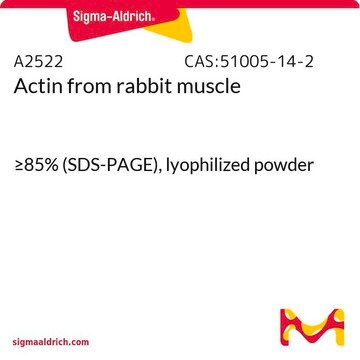A4700
Monoclonal Anti-Actin antibody produced in mouse
clone AC-40, ascites fluid
Sinónimos:
Monoclonal Anti-Actin
About This Item
Productos recomendados
biological source
mouse
Quality Level
conjugate
unconjugated
antibody form
ascites fluid
antibody product type
primary antibodies
clone
AC-40, monoclonal
mol wt
antigen 42 kDa
contains
15 mM sodium azide
species reactivity
human, Xenopus, hamster, mouse, guinea pig, rat, rabbit, snail, sheep, canine, carp, chicken, pig, bovine, viper, goat
technique(s)
immunohistochemistry (frozen sections): suitable using methanol-fixed, frozen sections
indirect ELISA: suitable
indirect immunofluorescence: 1:200 using cultured human or chicken fibroblasts
western blot: 1:500 using cultured human or chicken fibroblast extract
isotype
IgG2a
shipped in
dry ice
storage temp.
−20°C
target post-translational modification
unmodified
Gene Information
human ... ACTA1(58) , ACTA1(58) , ACTA1(58) , ACTA2(59) , ACTA2(59) , ACTA2(59) , ACTB(60) , ACTB(60) , ACTB(60) , ACTC1(70) , ACTC1(70) , ACTC1(70) , ACTG1(71) , ACTG1(71) , ACTG1(71) , ACTG2(72) , ACTG2(72) , ACTG2(72)
mouse ... Acta1(11459) , Acta1(11459) , Acta1(11459) , Acta2(11475) , Acta2(11475) , Acta2(11475) , Actb(11461) , Actb(11461) , Actb(11461) , Actc1(11464) , Actc1(11464) , Actc1(11464) , Actg1(11465) , Actg1(11465) , Actg1(11465) , Actg2(11468) , Actg2(11468) , Actg2(11468)
rat ... Acta1(29437) , Acta1(29437) , Acta1(29437) , Acta2(81633) , Acta2(81633) , Acta2(81633) , Actb(81822) , Actb(81822) , Actb(81822) , Actc1(29275) , Actc1(29275) , Actc1(29275) , Actg1(287876) , Actg1(287876) , Actg1(287876) , Actg2(25365) , Actg2(25365) , Actg2(25365)
¿Está buscando productos similares? Visita Guía de comparación de productos
General description
The antibody recognizes an epitope located on the C-terminal end of actin conserved in all actin isoforms. It specifically labels actin in a wide variety of tissues and species. The epitope recognized by the antibody is resistant to formalin-fixation and paraffin-embedding. Zinc-formalin, B5, ethanol, methacarn, Brunnel′s or Bouin′s solutions may also be used as fixatives.
Monoclonal Anti-Actin (mouse IgG2a isotype) is derived from the AC-40 hybridoma produced by the fusion of mouse myeloma cells and splenocytes from an immunized mouse. A synthetic actin C-terminal peptide attached to Multiple Antigen Peptide (MAP) backbone was used as the immunogen. The isotype is determined using Mouse Monoclonal Antibody Isotyping Reagents, Catalog No. ISO2.
Specificity
Immunogen
Application
- in the detection of actin in HeLa cells, breast cancer cell line and leukemia cell line using western blotting
- in human fibroblasts by immunofluorescence detection
Biochem/physiol Actions
The actin in cells of various species and tissues are very similar in their immunological and physical properties characterized by electrophoresis and amino acid sequence analysis.(from bulletin) They mediate cytoskeletal remodeling during T cell activation. Mutation in the γ-actin and β-actin gene is associated with a developmental disorder called Baraitser-Winter syndrome. Mutation in the γ-actin leads to hearing loss.
Physical form
Storage and Stability
Other Notes
Disclaimer
Not finding the right product?
Try our Herramienta de selección de productos.
Optional
Storage Class
11 - Combustible Solids
wgk_germany
WGK 1
Certificados de análisis (COA)
Busque Certificados de análisis (COA) introduciendo el número de lote del producto. Los números de lote se encuentran en la etiqueta del producto después de las palabras «Lot» o «Batch»
¿Ya tiene este producto?
Encuentre la documentación para los productos que ha comprado recientemente en la Biblioteca de documentos.
Los clientes también vieron
Nuestro equipo de científicos tiene experiencia en todas las áreas de investigación: Ciencias de la vida, Ciencia de los materiales, Síntesis química, Cromatografía, Analítica y muchas otras.
Póngase en contacto con el Servicio técnico














